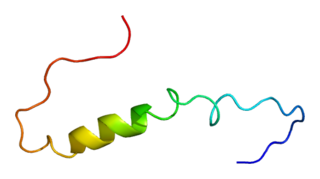
Bestrophin-1 (Best1) is a protein that, in humans, is encoded by the BEST1 gene.

Chloride intracellular channel protein 1 is a protein that in humans is encoded by the CLIC1 gene.

Potassium intermediate/small conductance calcium-activated channel, subfamily N, member 4, also known as KCNN4, is a human gene encoding the KCa3.1 protein.

Chloride channel accessory 1 is a protein that in humans is encoded by the CLCA1 gene.

Chloride channel accessory 2 is a protein that in humans is encoded by the CLCA2 gene.

Calcium-activated potassium channel subunit beta-2 is a protein that in humans is encoded by the KCNMB2 gene.

Calcium-activated potassium channel subunit beta-3 is a protein that in humans is encoded by the KCNMB3 gene.

Potassium intermediate/small conductance calcium-activated channel, subfamily N, member 2, also known as KCNN2, is a protein which in humans is encoded by the KCNN2 gene. KCNN2 is an ion channel protein also known as KCa2.2.

Voltage-dependent calcium channel subunit alpha-2/delta-1 is a protein that in humans is encoded by the CACNA2D1 gene.

Potassium intermediate/small conductance calcium-activated channel, subfamily N, member 1 , also known as KCNN1 is a human gene encoding the KCa2.1 protein.

Calcium-activated potassium channel subunit beta-4 is a protein that in humans is encoded by the KCNMB4 gene.

Voltage-dependent calcium channel gamma-4 subunit is a protein that in humans is encoded by the CACNG4 gene.

Potassium voltage-gated channel subfamily A member 6 also known as Kv1.6 is a protein that in humans is encoded by the KCNA6 gene. The protein encoded by this gene is a voltage-gated potassium channel subunit.

Chloride channel accessory 4, also known as CLCA4, is a protein which in humans CLCA4 gene. The protein encoded by this gene is a chloride channel. Protein structure prediction methods suggest the N-terminal region of CLCA4 protein is a zinc metalloprotease, and the protein is not an ion channel per se.

Chloride intracellular channel protein 3 is a protein that in humans is encoded by the CLIC3 gene. This protein is a chloride channel.

Anoctamin-1 (ANO1) also known as Transmembrane member 16A (TMEM16A) is a protein that, in humans, is encoded by the ANO1 gene. Anoctamin-1 is a voltage-gated calcium-activated anion channel, which acts as a chloride channel and a bicarbonate channel. additionally Anoctamin-1 is apical iodide channel. It is expressed in smooth muscle, epithelial cells, vomeronasal neurons, olfactory sustentacular cells, and is highly expressed in interstitial cells of Cajal (ICC) throughout the gastrointestinal tract.

Potassium channel subfamily T, member 1, also known as KCNT1 is a human gene that encodes the KCa4.1 protein. KCa4.1 is a member of the calcium-activated potassium channel protein family

Potassium channel subfamily T, member 2, also known as KCNT2 is a human gene that encodes the KNa protein. KCNT2, also known as the Slick channel is an outwardly rectifying potassium channel activated by internal raises in sodium or chloride ions.

CatSper2, is a protein which in humans is encoded by the CATSPER2 gene. CatSper2 is a member of the cation channels of sperm family of protein. The four proteins in this family together form a Ca2+-permeant ion channel specific essential for the correct function of sperm cells.

Anoctamin 5 (ANO5) is a protein that in humans is encoded by the ANO5 gene.














